How to Solve the Problem of Acid-resistant Stainless Steel Reaming and Chip Breaking?

Frequently encountered problems when reaming stainless steel are:
The surface of the hole is easy to be grooved, the roughness is poor, the aperture is out of tolerance, the bell mouth is formed, and the reamer is easy to wear. Different types of stainless steel have different machinability, and the problems exhibited in the reaming are also different. For example, when reaming austenitic stainless steel such as 1Cr18Ni9Ti and concentrated nitric acid resistant stainless steel, it is mainly the problem of reamer wear; When reaming a martensitic stainless steel such as 2Cr13, it is not easy to ensure the roughness and dimensional accuracy of the reaming.
In order to avoid these problems, you should pay attention to the following:
1. Reasonable selection of reamer and reaming is the key to ensuring smooth reaming.
2. Improve the quality of the pre-machining process to prevent the groove, ellipse, polygon, taper or bell mouth, waist drum shape, axis bending and skewing of the pre-machined hole.
3. Keep the material hardness of the workpiece moderate.
Especially for 2Cr13 martensitic stainless steel, the hardness after quenching and tempering treatment is preferably below HRC28.
4. Install the reamer and workpiece correctly.
The reamer must be installed correctly, and the axis of the reamer should be consistent with the axis of the pre-machined hole of the workpiece to ensure uniform cutting of each tooth.
5. The use of a suitable cutting fluid can solve the problem of stainless steel chip adhesion and smooth chip removal, thereby reducing the surface roughness of the hole and improving the durability of the tool. Generally, it is preferred to use a sulfurized oil. If 10% to 20% of CCl4 is added to the sulfurized oil or 20% to 30% of CCl4 is added to the lard, the surface roughness is remarkably improved. Since CCl4 is harmful to the human body, it is preferable to use a mixture of 85% to 90% of sulfurized oil and 10% to 15% of kerosene. When the diameter of the reamer is large, internal cooling can be used.
6. Paying careful attention to the process of reaming and strictly checking the amount of tooth movement is the key to obtaining uniform reaming. Pay attention to the shape of the chips during the reaming process. Due to the small amount of reaming, the chips are in the form of a foil or a very short spiral. If the size of the chips is different, some are in the form of broken pieces and some are in small pieces, indicating that the reaming is uneven. If the chips are in the form of a spring, the reaming allowance is too large. If the chips are needle-like or fragmented, the reamer has been blunt. Also to prevent chip clogging, should be diligent to observe the teeth with or without sticky debris to avoid the aperture is out of tolerance. Hole shrinkage occurs when reaming with a carbide reamer. To prevent the hole from being pulled when retracting, increase the lead angle to improve the situation.

In order to solve the problem of chip breaking during the drilling of acid-resistant stainless steel, a new type of acid-resistant stainless steel chip breaking group drill was developed. When it is drilled, the chips are discharged from the holes in a "fireworks" shape with a length of about 100 mm, and the chip breaking effect is very satisfactory.
The key to making this chip during the drilling process is:
First, the chipping point is in a critical state of chipping;
Second, it is necessary to properly grind the drill tip height (h=0.05D~0.07D) and the arc radius (R=0.2D);
Thirdly, the appropriate position of L1=1.7-3.3 mm should be selected, and with appropriate large feed and low cutting speed, chips will break in the oblique screw state.
When drilling with an acid-resistant stainless steel chip breaking group, a lower cutting speed and a larger feed rate should be used to facilitate chip breaking.





